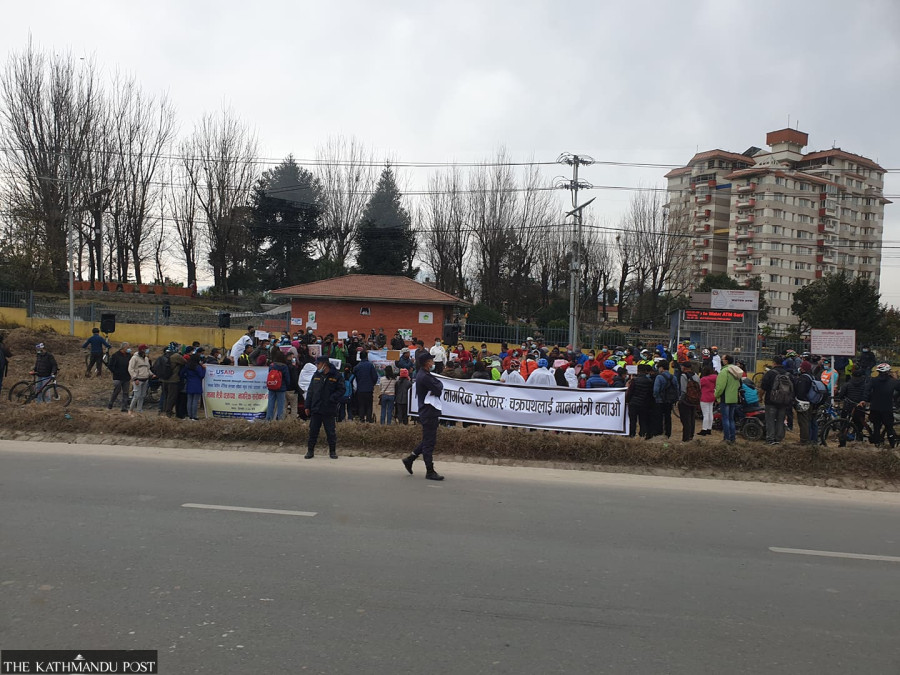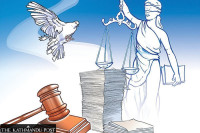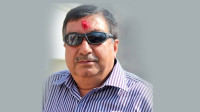National
USAID logo seen in civic march on Chinese-implemented Ring Road project. Nepalis see the geopolitical side of it
Aid agency denies its association in the campaign organised to demand that the Koteshwar-Kalanki section be made friendly for the disabled and pedestrians.
Shuvam Dhungana
As if the hullabaloo over the Millenium Challenge Corporation is not enough, the United States in Nepal has found itself embroiled in yet another controversy.
The USAID, a United States agency that administers foreign aid and assistance to various countries, on Saturday scrambled to dissociate itself from a civic campaign organised to demand that the 8.2 km Kalanki-Maharajgunj section of the Ring Road be made friendly for disabled persons, cyclists and pedestrians.
On Saturday afternoon, a group of people including cyclists, environmentalists, people with disabilities and artists organised what they called a “civic concern march.”
A banner carried by the campaigners had the logo of USAID.
Nepalis on Twitter were quick to see a geopolitical connotation in the US “involvement” in the Ring Road widening project undertaken by China.
“If you are invited to a program, you should first ascertain who has funded it otherwise you might get into trouble,” wrote Rameshore Khanal, a former finance secretary, on Twitter.
Replying to Khanal’s tweet, journalist Kanak Mani Dixit wrote, “If the invitation is for a good cause then we should participate without asking anyone. Even if it is later learnt that someone has funded the cause, we should not be afraid, nor regret, just look at the cause.”
And replying in the thread, another journalist Rudra Pangeni questioned, “What to do when they need funds to even organize a rally [march] demanding sidewalks?”
.jpg)
The USAID then posted a message on Twitter denying its involvement in the campaign.
“USAID/Nepal supports its local partner PHASE Nepal to empower individuals with disabilities to live independently and with dignity. We commend their work on disability inclusion across the country,” the American aid agency tweeted. “USAID/Nepal did not in any way initiate the organization of a civil protest in Kathmandu today. We are aware that USAID's logo was inappropriately used in the banners for this event and we are looking into the matter closely.”
PHASE Nepal is a non-governmental, non-profit and non-political and non-religious organization working in nine remotest districts of Nepal such as Humla, Mugu, Bajura to name a few, according to the organization's website.
Communications officer Meetum Bantawa Rai of PHASE Nepal refused to speak on the issue. “I can’t speak on this regard, we will inform later,” she told the Post.

Meanwhile, the march organizers ‘Ringroad civic concern’ issued a statement on Sunday saying their attention was drawn towards ‘some mistakes made by one of the participant organisations.’ The statement said they express sadness over the use of the USAID logo on one of the banners used and denied having received any kind of financial, technical or other assistance from USAID. The organisers’ rebuttal statement however does not include PHASE Nepal, the organization that had used the USAID logo, in the march.
Many in Nepal believe that the US-China rivalry oftentimes plays out in Nepal, and they see the MCC, under which Nepal is supposed to receive $500 million in grants, and the Belt and Road Initiative (BRI) under which China has pledged infrastructure projects, as the two economic giants’ tools to expand their influences.
While the MCC has failed to get through Parliament in the wake of deep divisions among politicians and communities, no substantial progress has been made in Nepal under the BRI.
American officials in the past have used some oblique phrases to suggest any development initiatives from China in Nepal should be in “Nepal’s interest rather than China’s.”
.jpg)
The MCC has become a controversial topic in Nepal as some say it has some clauses that undermine Nepal’s sovereignty. The United States has denied—through press statements and public service announcements. In September, Nepal’s Finance Ministry even wrote to the MCC headquarters outlining some concerns raised in the public sphere regarding the American grant. The MCC headquarters provided a point-wise rebuttal. Immediately after, MCC deputy vice president Fatema J Sumar visited Nepal and held a series of meetings with Nepali political leadership.
While the Chinese have made open statements that they have no objections to Nepal receiving the MCC grants, some reports claim the north has invested in discrediting the American grant programme.
Saturday’s episode involving USAID comes amid Prime Minister Sher Bahadur Deuba’s push to get the MCC through Parliament. In this regard, Deuba sought the support of KP Sharma Oli, the chair of the CPN-UML that has been obstructing the House proceedings for months.
Saturday’s march started from Narayan Gopal Chowk, a stone’s throw from the US embassy in Maharajgunj, and ended at the nearby Sankha Park, where a function was organised which involved poetry recitation, live painting to create awareness, and live music, among other activities.
.jpg)
On December 25, the group had prepared a joint memorandum of demands requesting the government and stakeholders to make the 8.2 km road section, which is being widened, friendly for all users besides vehicles. Ever since it became operational, the road section has earned notoriety for being dangerous for pedestrians—some even calling the stretch a death trap.
The construction of an eight-lane road began in the year 2013.
The Chinese government handed over the eight-lane Koteshwar-Kalanki section of the Ring Road to the government in January 2019. The road section was completed in five years at the cost of Rs5.13 billion.
Amid the back-and-forth on social media over the use of the USAID banner in the campaign, some users were quick to show their humorous side.
“I demand that the Ring Road intersection (chok) where the protest took place with the USAID banner be named ‘geopolitics chok’,” wrote a Twitter user with the handle @KTmite.
Anup Ojha contributed reporting.
.jpg)
.jpg)





 10.12°C Kathmandu
10.12°C Kathmandu















